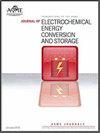PbO对Ir纳米表面乙醇在碱性介质中电催化氧化的促进作用
IF 1.9
4区 工程技术
Q3 ELECTROCHEMISTRY
Journal of Electrochemical Energy Conversion and Storage
Pub Date : 2023-07-25
DOI:10.1115/1.4063017
引用次数: 0
摘要
由于所谓的金属-氧化物相互作用(MOI),金属-金属(hydr)-氧化物界面可以提高乙醇氧化反应(EOR)的CO2选择性。在这里,我们首先表明,在纳米尺度上,Ir和PbO物种的混合物也可以形成“双功能效应”位点,其中乙醇的C-C键可以在Ir位点被有效切割以产生C1中间体,而附近的PbO物种可以提供含氧物种。事实上,所制备的平均金属纳米颗粒尺寸为2.6±0.5nm的Ir-PbO/C催化剂可以大大提高EOR的活性、稳定性和C1途径选择性。具体而言,它在含有1M C2H5OH的1M NaOH溶液中表现出1150 mA mg−1Ir的优异质量活性。计时电流法测试表明,与Ir/C相比,Ir-PbO/C的稳定性也显著提高。原位电化学红外吸收光谱结果证实,亲氧PbO物种的加入可以加速COad中间体的氧化去除,从而大大提高催化性能。这项研究可能为设计高效的直接乙醇燃料电池阳极催化剂提供新的见解。本文章由计算机程序翻译,如有差异,请以英文原文为准。
Promoting Effect of PbO on Ir Nanosurface Towards Ethanol Electrocatalytic Oxidation in Alkaline Media
Metal-metal (hydr)oxide interfaces can promote the CO2 selectivity of ethanol oxidation reaction (EOR) due to so-called metal-oxide-interaction (MOI). Here, we first show that the mixture of Ir and PbO species at the nanoscale can also form “bifunctional effect” sites, where C-C bond of ethanol can be effective cut at Ir sites to generate C1 intermediates, and nearby PbO species could provide oxygenated-species. Actually, the as-prepared Ir-PbO/C catalysts with a mean metallic nanoparticle size of 2.6±0.5 nm can greatly improve the activity, stability and C1 pathway selectivity of EOR. Specifically, it exhibits superior mass activity of 1150 mA mg−1Ir in 1 M NaOH solution containing 1 M C2H5OH. Chronoamperometry tests show that the stability of Ir-PbO/C is also significantly improved compared with Ir/C. In situ electrochemical infrared absorption spectral results confirm that the addition of oxophilic PbO species could accelerate the oxidative removal of COad intermediates, thereby greatly improving catalytic performance. This study may give new insights into designing efficient anode catalysts for the direct ethanol fuel cells (DEFCs).
求助全文
通过发布文献求助,成功后即可免费获取论文全文。
去求助
来源期刊

Journal of Electrochemical Energy Conversion and Storage
Engineering-Mechanics of Materials
CiteScore
4.90
自引率
4.00%
发文量
69
期刊介绍:
The Journal of Electrochemical Energy Conversion and Storage focuses on processes, components, devices and systems that store and convert electrical and chemical energy. This journal publishes peer-reviewed archival scholarly articles, research papers, technical briefs, review articles, perspective articles, and special volumes. Specific areas of interest include electrochemical engineering, electrocatalysis, novel materials, analysis and design of components, devices, and systems, balance of plant, novel numerical and analytical simulations, advanced materials characterization, innovative material synthesis and manufacturing methods, thermal management, reliability, durability, and damage tolerance.
 求助内容:
求助内容: 应助结果提醒方式:
应助结果提醒方式:


